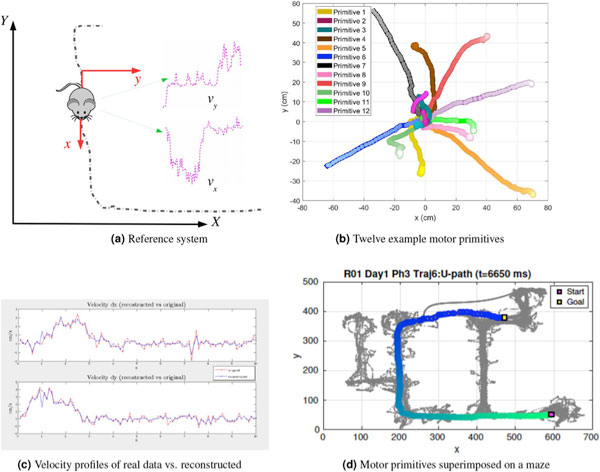We know that animal behavior follows structured patterns but formalizing these patterns is challenging. Here, we present a novel machine learning methodology that identifies structured behavioral patterns from data that are routinely collected during behavioral experiments; for example, rodent spatial navigation experiments (see Figure 1A). This methodology enables identification of a dictionary of basic building blocks of animal movement – called “motor primitives” (see Figure 1B) – to study how they are combined and chained in time to derive sophisticated movements, and ultimately to describe the animal’s behavioral repertoire in a compact way.

Figure: Schematic illustration of the methodology to identify structured behavioral patterns within rodent spatial trajectories. (a) The methodology takes as inputs the animal’s behavioral variables, such as its position in time. (b) Based on such behavioral data, the methodology builds a dictionary of movement building blocks, called “motor primitives”. (c-d) Using the dictionary of motor primitives, it is possible to reconstruct the behavioral data and to classify animal choices and movement types.
We show that our methodology affords a very good reconstruction and prediction of animal movements across successive experimental sessions (see Figure 1c-d). Furthermore, and more interestingly, we show that our methodology can support experimental analyses in various ways. For example, it permits identifying movement types and stereotypy in movements that may be indicative of habit formation; inferring some aspects of the environment in which the animals operate (e.g., maze complexity); classifying the animal’s behavioral choices; and is predictive of some aspects of the neural coding of spatial navigation (e.g., the displacement of so-called “place cells” and “grid cells” in the rodent hippocampus and entorhinal cortex, respectively). For all these reasons, this methodology can be useful for behavioral scientists and neuroscientists as an aid for sophisticated behavioral and neural analysis.
|
HFSP award information Research Grant - Early Career (RGY0088/2014): Beyond simple choices: computational and neuronal mechanisms for complex spatial behaviors Principal investigator: Matthijs Van der Meer, University of Waterloo, Canada (nationality: Netherlands) |


































